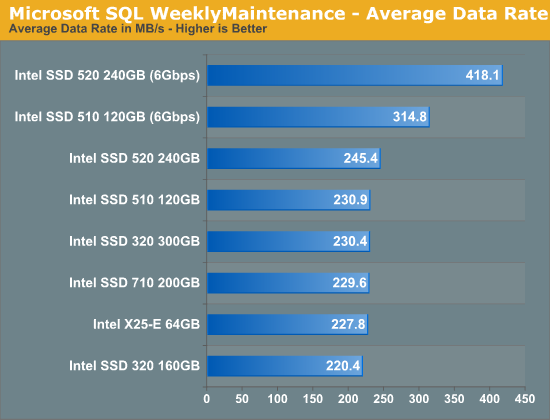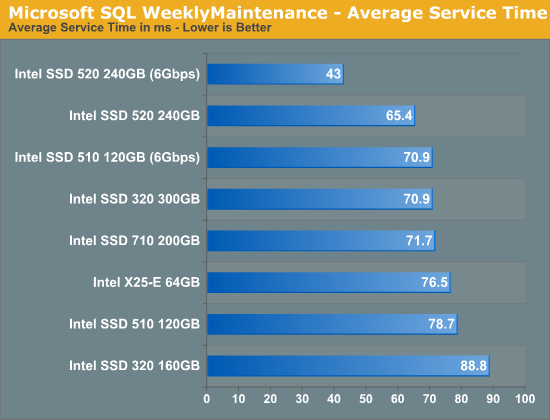A Look at Enterprise Performance of Intel SSDs
by Anand Lal Shimpi on February 8, 2012 6:36 PM EST- Posted in
- Storage
- IT Computing
- SSDs
- Intel
Enterprise Storage Bench - Microsoft SQL WeeklyMaintenance
Our final enterprise storage bench test once again comes from our own internal databases. We're looking at the stats DB again however this time we're running a trace of our Weekly Maintenance procedure. This procedure runs a consistency check on the 30GB database followed by a rebuild index on all tables to eliminate fragmentation. As its name implies, we run this procedure weekly against our stats DB.
The read:write ratio here remains around 3:1 but we're dealing with far more operations: approximately 1.8M reads and 1M writes. Average queue depth is up to 5.43.

Again, huge gains from the 520 on a 6Gbps interface. Moving over to a 3Gbps interface, all of these drives basically perform the same thanks to the 3Gbps SATA limitation.


Enterprise Storage Bench - Microsoft SQL UpdateDailyStats
Measuring How Long Your Intel SSD Will Last










55 Comments
View All Comments
jeremyshaw - Wednesday, February 8, 2012 - link
woah... I've been waiting for an article like this for a long time.Thank you Anandtech!
ckryan - Wednesday, February 8, 2012 - link
Is AnandTech ever planning on doing a longer period SSD test? A long term testing scenario would make for interesting reading.Anand Lal Shimpi - Wednesday, February 8, 2012 - link
Technically all of our SSD tests are long term. We're still testing Vertex 2 class drives and I actually still have six Intel X25-M G1s deployed in systems in my lab alone. You only hear about them when things go wrong. Most of the time I feed errors back to the vendors to get fixes put into firmware updates. The fact that you aren't seeing more of this sort of stuff means that things are working well :-PBut the results of our long term tests directly impact our reviews/recommendations. It's one of the reasons I've been so positive on the Samsung SSD 830 lately. I've been using 830s 24/7 since our review published in September with very good results :)
Take care,
Anand
Samus - Thursday, February 9, 2012 - link
I've had an X25-M G1 in my Macbook since 2009, used daily, never a problem. Lack of trim support doesn't really seem to matter unless you're the type the writes/deletes a lot of data.jwilliams4200 - Wednesday, February 8, 2012 - link
Since you found that the 520 does not really do any better than the 320 for endurance, does this also imply that the Sandforce controller was not able to achieve significant compression on the workload that you fed to it? In other words, Sandforce compression does not work very well on real data as opposed to artificial benchmark data.ckryan - Wednesday, February 8, 2012 - link
SF is really good at compressing fake data. I suppose some logs could really benefit, but one of my personal SF drives has 10% more raw writes than host writes. I suspect I'm not alone with this either.People doing repeated incompressible benches could have WA higher than 1 with SF, but once you install the OS and and programs, every day writes are less compressible than promised it would seem.
Anand Lal Shimpi - Wednesday, February 8, 2012 - link
Keep in mind that only 10% more NAND writes than host writes is *really* good. It's not uncommon to get much, much higher than that with other controllers.We did an 8 month study on SF drives internally. The highest write amp we saw was 0.7x. On my personal drive I saw a write amp of around 0.6x.
Take care,
Anand
jwilliams4200 - Thursday, February 9, 2012 - link
Baloney!You just saw a write amplification of near 1 on this very article. Why do you dodge my question?
erple2 - Thursday, February 9, 2012 - link
I suspect that the workloads that they were testing for with the SF drives internally are not what is reflected in this article.That implies, then, that the SF drives have been doing other workloads like acting in desktops and/or laptop duties. For those kinds of things, I suspect that a 0.6-0.7x is more reasonable (assuming there isn't much reading/writing of incompressible data).
Given that some of the workload may be for mobile applications, and given a strong focus on WDE for laptops, I wonder how that ultimately impacts the write amplification for drives with WDE on them.
jwilliams4200 - Thursday, February 9, 2012 - link
The "8 month study" that he refers to is very hard to believe.Does he really expect us to believe that the people in Anand's test lab used these SSDs for 8 months and did not run any benchmarks on them?
Most benchmarks write easily compressible data, and a lot of it.
The real way to test the Sandforce compression is to write typical user data to the SSD and monitor the raw write and host write attributes. That experiment has already been done on xtremesystems.org, and the findings were that typical user data bare compresses at all -- at best raw writes were 90% of host writes, but for most data it was 100% or higher. The only thing that got some compression was the OS and application installs, and most people only do those once, so it should not be counted towards user data when estimating endurance.